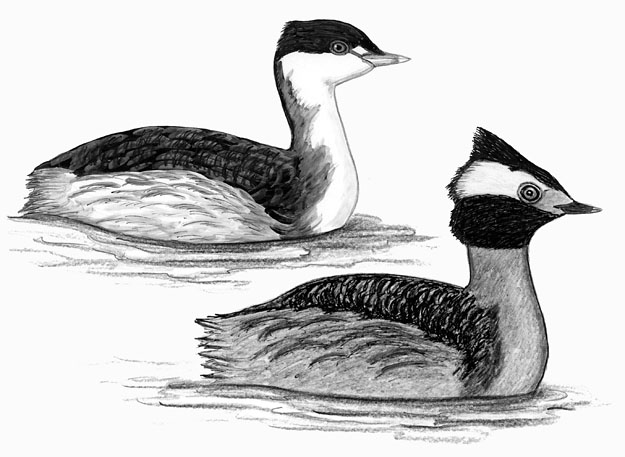
Dear Bird Folks,
I was walking around Provincetown (MA) last week, when I noticed a group of people looking through a telescope (or some kind of spying device). When I got a little closer, one of them turned to me and said, “Want to have a look?” Feeling adventurous I took a look, but didn’t see anything special. He asked: “Did you see the horned…” [something or other]. I told him that I did, thanked him and kept walking. The truth is, the only thing I saw was a flock of birds floating in the water and none of them had horns. Any idea what I was supposed to have seen?
–Neil, Rochester, MA
You are brave, Neil,
I don’t think I would have had enough guts to accept an invitation to “have a look” from a stranger, especially in Provincetown. Who knows what freaky thing could have been at the other end of that “spying device.” But the real reason I said you are brave is because the people you approached were birders. Birders! Are you crazy? Talk about freaky people.
I’m pretty sure that those “horned something or other” the birders wanted you to see were Horned Grebes. The reason I’m confident about what you saw is because I too was in Provincetown last week and saw several Horned Grebes in the harbor. (However, I was smart enough to avoid the birders. I have a reputation to protect and can’t afford to be seen with those people.) Horned Grebes are harmless little water birds and not at all scary. They are fairly common around the Cape this time of year and are most often found in saltwater, which Cape Cod has a lot of.
Like many birds, Horned Grebes only showoff their namesake features during the breeding season. That is why you didn’t see any birds with horns. In the winter, Horned Grebes are basically gray and white and are totally hornless. However, it all changes during the breeding season when their necks and bodies become covered in brilliant rufous-red feathers. They also grow vivid yellow feather tufts (the horns) on the sides of their heads, which makes them look like the love children of Lady Gaga and Grandpa Munster.
Grebes are unusual birds. In fact, they are so unusual that researchers have had trouble determining which other birds they are related to. They look and act like ducks, spending their entire lives swimming and diving in water. But they don’t have typical duck-shaped bills, don’t have webbed feet and don’t ever quack, except when doing impressions at parties. Experts eventually decided that grebes were more closely related to loons and not ducks. Everyone was happy with that until further research discovered that the loon theory was also wrong.
Determined not to give up, the scientists next broke out their handy-dandy DNA testing kits. When the tests came backs the scientists were stunned by what they found. I mean they were completely shocked. You could see jaws dropping and hear clipboards hitting the floor all over of the lab. Wanna guess what they found? Keep in mind that grebes are chunky, medium-sized duck-like water birds. They are superb underwater swimmers, but struggle to stand or walk on land. What’s your guess? According to DNA testing, grebes are related to…flamingos. That’s right; those tall, long-legged wading birds that are bright pink, and sometimes made of plastic, are the closest living relative to the little birds you saw swimming in Provincetown Harbor. How about that? Surprised? You can pick up your clipboard now.
Another odd thing about grebes is that they have the craziest feet you’ll ever see on any bird. Instead of being webbed, like most waterfowl, a grebe’s foot has three separate, paddle-shaped toes. It is not clear why grebes have paddle toes instead of webbed feet but they certainly work great. A frightened grebe will quietly submerge and may swim underwater for hundreds of feet before surfacing safe and undetected in distant vegetation. In addition to having weird toes, grebes also eat their own feathers, and they do it on purpose. They even feed feathers to their babies. Why? Grebes eat a lot of fish and fish contain lots of sharp bones. It is thought that the birds protect their stomachs from the bones by eating soft feathers. Keep that last piece of information in mind, Neil, the next time a grebe asks to borrow your pillow or feather boa. Don’t do it.
On a related subject: You mentioned that the birders in Provincetown were looking through a “telescope.” They weren’t. Birders don’t use telescopes. They use “spotting scopes.” Spotting scopes are designed for terrestrial purposes such as bird watching or looking in your neighbors’ windows. Telescopes don’t work very well for studying things on land. They are better for seeing stars, planets and aliens. Spotting scopes are usually black or dark green, rugged, compact and designed for constant use. Telescopes are long, white tubes. Folks typically use them only once or twice. After that they put them in the closet right next to their treadmill, fondue set and all of their other bad ideas. Never buy a birder a telescope. A spotting scope is what they need for seeing birds. One word of caution: If you decide to use your scope to look in people’s windows, just make sure you don’t look in the window of Lady Gaga and Grandpa Munster. It would take you years of therapy to get that image out of your head.